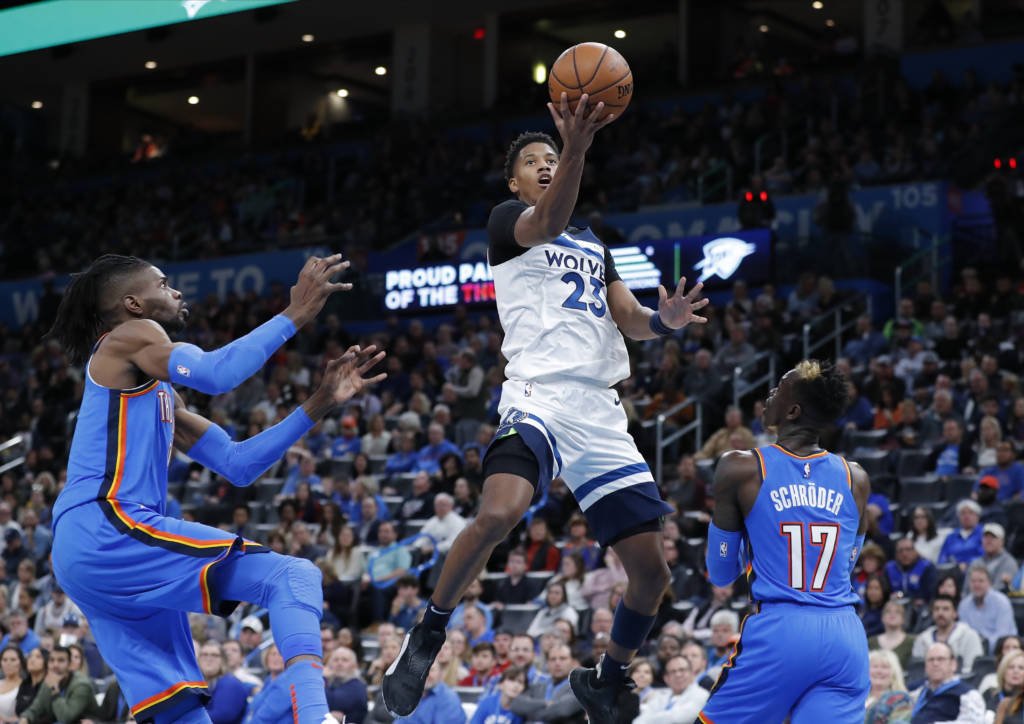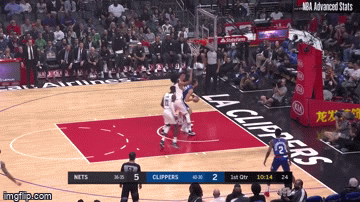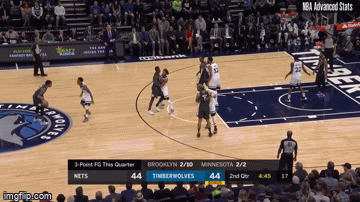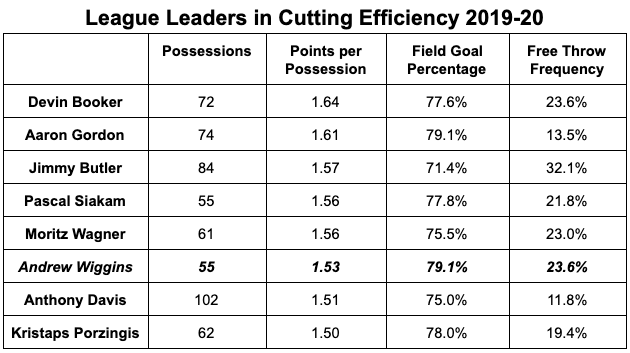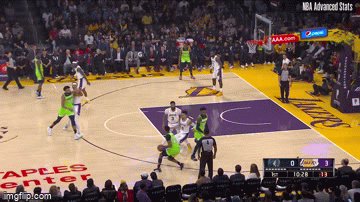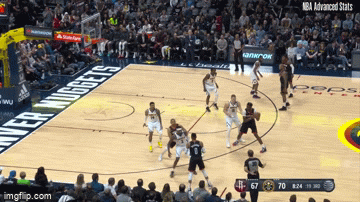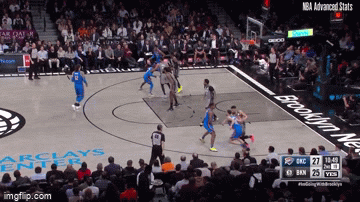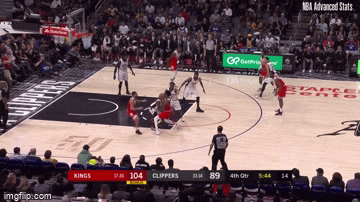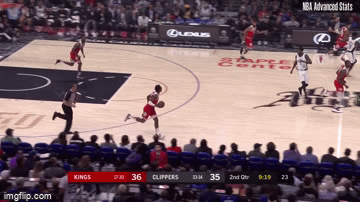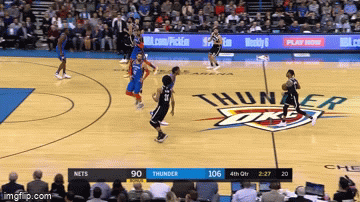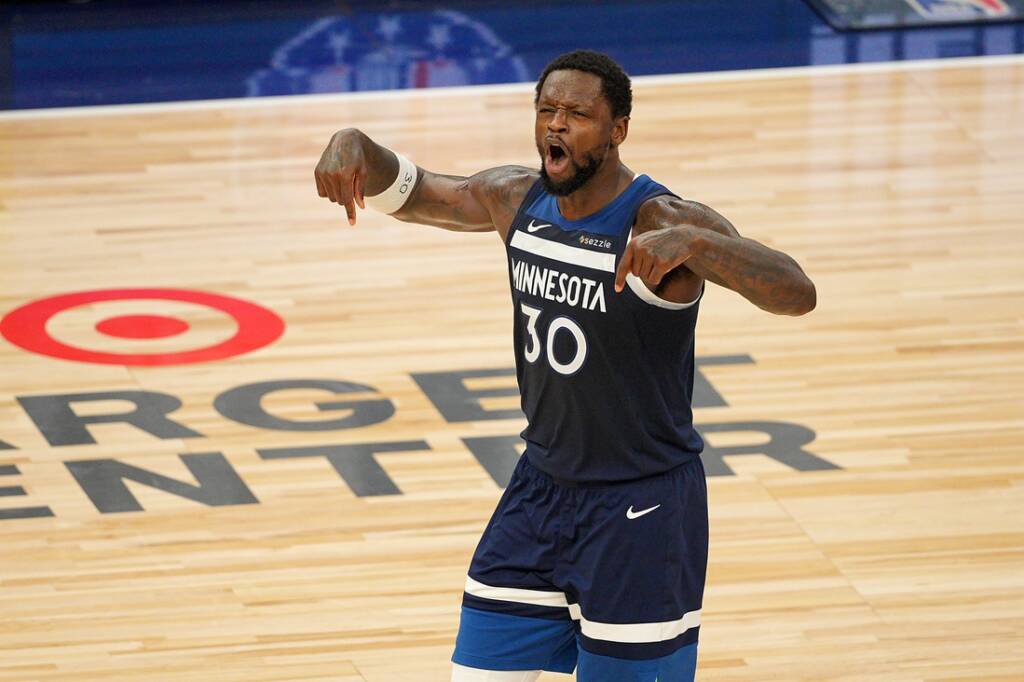We now know the blueprint.
In Gersson Rosas’ wheeling and dealings at the trade deadline that eventually landed D’Angelo Russell, Malik Beasley and Juancho Hernangomez, Rosas not only illustrated that this new Minnesota Timberwolves front office was going to be an active one, but he also illustrated what that activity would look like.
In short, Rosas and Co. are targeting imbalances on other rosters. The thought is that a player who might not fit in their current home can fit on a Minnesota roster that is comfortable with the fact that they’re still taking shape.
Beasley and Hernangomez were buried on the Denver depth chart, creating an imbalance between their talent level and production output. Recognizing this coupled with the fact that both players were also on expiring contracts made them marks in Rosas’ eyes. Denver would only want to negotiate new deals for Beasley and Hernangomez this summer at their production output while Rosas could offer roles that could provide the opportunity to be paid closer to their talent levels.
The circumstantial imbalance in realities between what was happening in Denver versus Minnesota made it so a mutually beneficial deal could be struck.
Russell was a trade target because there was also an imbalance in Golden State.
In that case, the asymmetry was a product of Russell’s wonky fit alongside Steph Curry and Klay Thompson. Minnesota could offer not only a better positional fit next to Curry and Thompson in Andrew Wiggins but also tertiary benefits that effectively sweetened the pot.
In addition to Wiggins, the Minnesota front office also parted with their 2021 first-round pick and absorbed the contracts of Jacob Evans and Omari Spellman, so Golden State could duck the luxury tax line. Giving the Warriors tax relief and a player who fit their system better did not come at any real cost to the Wolves. In Rosas’ eyes — that see Russell to be a better fit in Minnesota than Wiggins — this trade was also mutually beneficial.
It is these types of imbalances around the league that Rosas will continue to scour for.
If we assume Russell and Karl-Anthony Towns are off the table for future negotiating purposes, then Rosas is left to parse through the remaining assets on the roster and in the draft pick coffer. These are the known pieces he has to work with:
- James Johnson‘s expiring contract: one year, $16.1 million
- The remainder of Jarrett Culver‘s rookie contract: three years, $20.6 million (team option in final two years)
- The remainder of Jake Layman‘s contract: two years, $7.7 million
- The remainder of Josh Okogie‘s rookie contract: two years, $6.8 million (team option in final year)
- The remainder of Evans’ rookie contract: two years, $5.6 million (team option in final year)
- The remainder of Spellman’s rookie contract: two years, $5.6 million (team option in final year)
- The non-guaranteed contracts of Jarred Vanderbilt ($1.7 million), Jaylen Nowell ($1.5 million) and Naz Reid ($1.5 million)
- All of Minnesota’s own first-round picks, save the 2021 pick (traded to Golden State)
- Brooklyn’s 2020 first-round pick (16th overall)
- All of Minnesota’s own second-round picks, save the 2021 pick (traded to Golden State)
- The greater of Denver and Philadelphia’s 2022 second-round pick (Jimmy Butler trade)
Outside of Johnson’s bloated deal, none of those contracts are demonstrably negative assets. In theory, then, the remaining roster pieces could be traded along with draft compensation for a player who — similar to Beasley, Hernangomez and Russell — becomes available on the trade market due to an imbalance in their current home.
This could lead to an array of different types of trades to be pursued.
But because so many of those non-Johnson contracts on the books carry small annual salaries, the only way the Wolves can acquire a player in the salary range of $15 million-plus is to include Johnson’s $16.1 million expiring deal as salary-matching fodder. And if that range is to be expanded to the $25 million-plus range, Culver’s $6.1 million in salary for next season also has to be included in any two-for-one package.
If Johnson and Culver were to be shopped as a package this offseason, their outgoing salary total would be $22.2 million. By league rule, $22.2 million can be traded for up to $27.7 million in salary or for as low as $16.2 million.
Around the league, the players that typically fall in that range are on their second contract in the league and are typically between 24 and 27 years old. It’s the amount of money a player who had success on their rookie contract signs for when they project to be somewhere between a starter and an All-Star.
Listed below are four players in or around that age and salary range. Given their tenure in the league, these players in this bundle fit the age curve of Towns and Russell. If one of these players were to be deemed a system fit in Minnesota and also a somewhat shaky fit in their current home, it would make some sense that they could be pursued in a trade where Johnson and Culver were the outgoing salaries.

Caris LeVert — Brooklyn Nets
(2020-21 salary: $16.2 million; remainder of contract: Three years, $52.5 million)
LeVert, 25, signed a three-year, $52.5 million contract extension last fall that is set to kick in for the 2020-21 season. While LeVert is almost certainly a positive value on that deal, Kevin Durant‘s returning presence could make an additional perimeter creator, like LeVert, redundant in Brooklyn.
It seems likely that Johnson and Culver may not be enough of a return. Rosas would likely need to sweeten the pot. Ironically, Minnesota owns Brooklyn’s first-round pick in the 2020 draft. Might that be enough of a sweetener to the package to pry away LeVert? Maybe more, maybe less.
Who knows?
But if Minnesota were able to secure LeVert, they would be able to reunite him with both Russell and Pablo Prigioni — both of whom spent the 2018-19 season in Brooklyn. Of the nine players Russell shared the floor with that season for over 500 minutes, he had his best offensive rating with LeVert.
LeVert is an extremely fast straight-line runner, and he pushes himself. He’s a player who could further unlock Russell in a Wolves system that is heavily-reliant on playing with pace.
The two could also find synergy in the halfcourt, as Russell is a high-level distributor and LeVert is a willing cutter.
This cutting element of LeVert’s game would also be beneficial for Towns. In Minnesota’s inverted offensive system that frequently runs through Towns at the top of the key, there is a need for competent off-ball cutters. This was an area of the game that Wiggins thrived in. Wiggins cuts have generated 1.53 points per possession this season — the sixth-best rate in the league.
The below play was a basic but frequent cutting action the Wolves ran for Wiggins through Towns.
Given that Towns’ shot must be respected from beyond the arc, a cutter — like Wiggins or LeVert — are empowered by the room provided to slash to the rim. In the above play, the extra step JaVale McGee has to play out onto Towns makes him a step further away from recovery to the rim. This leads McGee to not only be unable to deter Wiggins’ shot on the cut but his tardiness also causes him to commit a foul in the process.
—

Clint Capela — Atlanta Hawks
(2020-21 salary: $16.0 million; remainder of contract: Three years, $51.3 million)
If there is a position the Wolves are least likely to trade for, logic would say that it has to be center. That said, there are functionally three different archetypes of centers — and it’s arguable that one of those prototypes fit next to Towns.
- The traditional, physically imposing five. A back-to-the-basket offensive player who profits in the paint, often through post-up situations. On defense, they are more of an at-the-rim deterrent than they are versatile. Think Steven Adams, Jonas Valanciunas or Andre Drummond.
- The stretch-five. A floor spacer who helps the geometry of the offense but carries athletic shortcomings that limit their ability to put pressure on the rim due to their inability to cut or play with pace. Defensively, they’re often slow, similar to a traditional big — limiting their defensive versatility. Think Meyers Leonard, LaMarcus Aldridge or Gorgui Dieng.
- The rim-rolling, athletic five. A player who often occupies the dunker spot on offense, frequently being used as a ball-screener in the pick-and-roll. Defensively, their hallmark is versatility more so than it is physicality.
Capela, also 25 years old, fits the latter group. This type of big profiles as a partner for Towns given the attributes that yin to Towns’ yang. Towns is an elite floor-spacer who profits in pick-and-roll action through his ability to pop. But because Towns doesn’t possess the same type of quick-twitch spring that a player like Capela has, he has never been used as a high-volume roll man.
The Wolves ran a five-out offense this season that occasionally rolled Towns into the post, shifting the offense to four-out in those situations. If Capela played next to Towns, the Wolves could still run a four-out offense. And when Capela rested, the second-unit could swing back to playing five-out. If massaged correctly, Capela’s presence could tip the scales without throwing them off-balance.
This is the role Capela occupied during his time in Houston that overlapped Rosas’.
Again, the Wolves offense has missed a true rim-rolling option like Capela this season. With Russell’s pick-and-roll prowess, it’s arguable that this archetype of player has only become more desirable.
LeVert was Russell’s most effective offensive partner in Brooklyn, but his second-most efficient offensive partner was Jarrett Allen — a player molded in Capela’s image. Of Russell’s 563 assists during the 2018-19 season, 104 of them went to Allen. With a true rim-roller, Russell would have the option of throwing a lob in the mid-range rather than simply firing a jump shot.
It would take time for Towns and Capela to find an offensive synergy that stayed out of each other’s way. Remember Towns crashing into Dieng on his drives back in the day?
But that offensive wonkiness would come with the additional benefit of Capela’s ability to buoy Towns defensively.
Part of the anxiety that has come with the idea of Towns sliding to the four defensively is borne out of the idea that he may not be able to get out and defend out on the wing. Much of that fear would be mitigated if Towns’ frontcourt partner was a player like Capela. For years, Capela has racked up experience switching onto smaller players.
Atlanta did just trade for Capela at the deadline. Due to injury, he hasn’t even played a game in a Hawks jersey.
That said, Atlanta does have both John Collins and Dewayne Dedmon under contract for next season. Collins is also extension eligible this summer. If a team-friendly deal can be struck with Collins, does Capela become expendable? Could Culver’s defensive potential and the Brooklyn pick (16th overall) entice an Atlanta team that craves defense? Ironically, it was that exact Brooklyn pick that Atlanta traded — along with Evan Turner — to acquire Capela in the four-way deadline deal that included Minnesota.
—

Dennis Schroder — Oklahoma City Thunder
(2020-21 salary: $15.5 million; remainder of contract: One year, $15.5 million)
While LeVert and Capela both have three years left on their $16 million per season deals, Schroder, who is 26 years old, only has one year and $15.5 million left on his contract. This means Schroder would still fit the Towns and Russell age bubble but, for trade purposes, would have to be viewed as more of rental than an investment.
Like Capela with Towns, Schroder positionally overlaps with Russell. There could, however, be a similar yin and yang element to this fit as well.
In Oklahoma City this season, Schroder shared the backcourt with Shai Gilgeous-Alexander for 1,166 of his 1,952 minutes, and with Chris Paul for 990 of those minutes. Schroder, Gilgeous-Alexander and Paul have even shared the floor as a trio for 401 minutes. The Thunder’s production with those three players playing in tandem or as a triumvirate suggests that in the right system Schroder can not only co-exist with another lead guard but also thrive.
These numbers are staggering, particularly on the defensive end:
Russell is nowhere near the caliber of defender Gilgeous-Alexander or Paul are, but the elite level the Thunder have defended with Schroder on the floor next to those two could inspire the notion that the Wolves might be able to survive with a Russell and Schroder pairing. It wouldn’t be perfect but Russell, who is 6-foot-5 in shoes, does have a 6-foot-10 wingspan.
Theoretically, Russell could take the opponent’s bigger backcourt option while Schroder, who is slight but fast (6-foot-1, 172 pounds), could defend the quicker backcourt option. (Okay, this is optimistic — but at least Russell isn’t also tiny.)
Schroder particularly thrived in that multiple lead-guard look when playing alongside Danilo Gallinari and Adams this season.
On the offensive end, Towns approximates what Gallinari does as a floor-spacer and what Adams does in the paint. The below pick-and-roll is already a dynamic action with Gilgeous-Alexander and Gallinari when surrounded by Schroder. But if Russell and Towns were the core of the action while flanked by both Schroder and Beasley, I’m not sure how you defend it.
Every wrinkle of that action is dynamic — Russell off the screen; Towns on the pop; Schroder as the threat to slash; Beasley spotting up.
And in a simple two-man game with Schroder initiating, he could do even more with Towns that he has been able to do with Adams.
Again, it’s only one side of the ball, but if Minnesota got Schroder’s offensive production from this season and paired it with Russell, Towns and Beasley, it’s easy to see how the Wolves could become one of the best offensive teams in the league. With doubling down on the Towns and Russell pair, Rosas has already bet big on offense carrying this group.
Trading Culver for Schroder would be Rosas pushing the rest of his chips into the offensive end of the table.
The fact that Schroder would be a rental, and thus expiring before the big free agency summer of 2021, is another interesting element to this hypothetical. It’s long been my belief that these two first years of Rosas’ tenure are just a preamble meant to set up the franchise for the summer of 2021.
At that point in time, when Towns and Russell are 26, that’s when I’ve always thought Rosas would go all-in from a roster standpoint.
For that 2021 season, currently, the three most expensive contracts the Wolves have on the books are Towns ($31.7 million), Russell ($30.0 million) and Culver ($6.4 million). If Culver were to be moved in the deal for Schroder, his salary, while reasonable, would not be on the books for that summer. If Rosas has aspirations of adding a third max-level salary to the mix in 2021, the rest of the roster will need to be extremely lean.
Replacing Culver’s cap hit with Schroder’s free agency would trim things down.
To dump Culver, a lottery pick just a season ago, would be a hefty price to pay for a rental and a bit of cap relief. But Minnesota would still hold Schroder’s Bird Rights after his contract expired. Rosas could use those rights to go over the cap to re-sign Schroder if that was deemed valuable.
But even if it was just a one-and-done, Schroder could theoretically be put into a sign-and-trade out of Minnesota that would recoup some of the value paid to acquire him. That might not be a ton of value, but it is something. It’s no sure thing that Culver, who is set to make $6.4 million in 2021-21 and $8.1 million in 2022-23, will carry much value at that time.
The rolling with Schroder hypothetical option may carry more ambiguity than the LeVert or Capela paths, but in that ambiguity may come a discount. It seems fair to assume that the draft compensation attached to Johnson and Culver would be far less in a trade for Schroder than it would for LeVert or Capela.
That’s part of the calculation, too.
—

Buddy Hield — Sacramento Kings
(2020-21 salary: $26.4 million; remainder of contract: Four years, $94 million)
If Rosas was able to work a trade that sent Johnson and Culver to the Sacramento Kings for Hield, the Wolves would arguably become the best 3-point shooting team in the league.
Think about it: A starting lineup led by Russell’s well-beyond-the-arc range, flanked by Beasley and Hield’s elite ability to position and re-position in every 3-point quadrant, all capped by the fact that those three would all be orbiting around Towns, the best shooting big man in the game.
To pair the 27-year-old Hield with Towns, Beasley and Russell would make up a foursome of not only high-level shooters but, more importantly, high-volume threats.
To become one of the league’s premier shooting teams would be an astounding progression given that the Wolves were dead last in 3-point percentage prior to the deadline. This type of upward shift would be immense:
- A healthy Towns replaces his injury fill-in Reid, who has made 33.0 percent of his 3s this season.
- Russell steps in for Jeff Teague and Shabazz Napier, who combined to make 32.5 percent of their 246 3-point attempts while in Minnesota this season.
- Beasley and Hield take over the roles filled by Culver, Treveon Graham and Okogie. Of the 190 players who have taken 100 catch-and-shoot 3s this season, Culver (29.3 percent), Graham (26.6 percent) and Okogie (26.6 percent) rank 181st, 189th and 190th in that category. Beasley and Hield have both made over 40 percent of their catch-and-shoot looks this season.
An added benefit of carrying four elite shooters in the starting lineup would be not needing to have the fifth starter be a shooter. The counter line of thinking here comes from the idea that whoever was defending that non-shooter would be able to help. But that’s where Hield’s unique floor-spacing ability comes in.
Hield is not just a floor-spacer; he’s a space-finder.
In Sacramento, Hield has proven to be a tireless mover who feasts on shifting defenses. Help defense forces rotations, and Hield lives to counter defensive gyrations.
In Towns, the Wolves already have the elite pick-and-pop big. In Russell, they have the extended-range lead-guard who can pull from anywhere with ball-in-hand. And in Beasley, they have a high-level spot-up threat. Hield’s shooting skill set is a combination of what Beasley and Russell do best. He’s not only a spot-up threat; he can create space for himself.
Towns would naturally benefit from the added presence of an elite shooter, but the idea that he would have not one but three players to run a pick-and-pop with is just scary.
How do you defend a popping big when the lead-guard can do this?
Russell would also greatly benefit from being flanked by two elite shooters when he instigates a pick-and-roll. Looking at the 2018-19 Brooklyn team, it would be reminiscent of when Russell ran pick-and-roll with Allen while surrounded by Joe Harris.
Imagine how much more dangerous this Russell-led action becomes if Towns is in Allen’s place and Beasley is in Allen Crabbe‘s spot on the weak side.
The big difference in moving for Hield rather than LeVert, Capela or Schroder is the fact that he makes $10 million more per season than those three — and is under contract for the next four seasons. Inheriting the $94 million remaining on Hield’s contract would be a massive undertaking.
That said, if we assume Hield is a similar-caliber player to those other three, the spike in his salary would theoretically make him a more attainable piece. If the price tag for LeVert or Capela is Johnson, Culver and a future first, how much does the draft compensation get to decrease for Hield? Keep in mind that Bogdan Bogdanovic began starting over Hield in the final month of the season and is a free agent this summer.
It’s not ridiculous to think that Sacramento could be actively looking to move Hield this summer.
Adding another big salary would also come with what could be viewed as another situational benefit for Minnesota: salary-matching for a future trade. Currently, the dream of the Wolves being able to work a deal for a player like Devin Booker crumbles because they just don’t have a big enough salary — outside of Towns and Russell — that could be used to match Booker’s annual rate. Hield makes about $5 million annually less than Booker. That matches.
If the Wolves front office is playing three-dimensional chess, trading for a player at Hield’s price tag could be a move that eventually sets them up to make a corresponding move for a max-salary player — like Booker.
—
Honorable Mentions
Zach LaVine — Two years, $39 million remaining
Think about LaVine’s coaches in his career — Flip Saunders, Sam Mitchell, Tom Thibodeau, Fred Hoiberg and Jim Boylen. Did the styles of any of those coaches match LaVine? In Minnesota, LaVine would be free to bomb from deep and be empowered to play with pace.
The defense would be a mess, but Rosas already punted on the idea of being an above-average defensive team when he paired Russell with Towns.
Gary Harris — Two years, $39.7 million remaining
Harris hasn’t been a good 3-point shooter for two seasons now (33.3 percent this season and 33.9 percent in 2018-19). Making another deal with Denver for Harris would be about acquiring a piece who could help stabilize the defense. Paul Millsap entering the mix in Denver has received a lot of the credit for helping a Nikola Jokic-led team becoming above-average defensively.
But Harris has played an underrated role in Denver’s defensive ascension.
Harris and Okogie would give the Wolves two different dynamic defensive looks at the point-of-attack.
Myles Turner — Three years, $54 million remaining
If Rosas does pull the trigger on pairing Towns with another center, that player will likely look more like Capela than Turner. That said, Turner is the rare stretch-five who can also defend the rim at a high-level. To acquire Turner would be to make him Brook Lopez to Towns’ Giannis Antetokounmpo.
Victor Oladipo — One year, $21 million remaining
This would be a weird one. It might not be in a trade to Minnesota, but the idea that Indiana would move Oladipo before his contract expires after the 2020-21 season isn’t ridiculous. Indiana was 30-17 before Oladipo returned and have gone 9-9 since he returned. Oladipo’s offensive fit around the new presence of Malcolm Brogdon has been wonky — the Pacers are 27th in offensive efficiency since Oladipo returned.
Similar to the Schroder hypothetical, Oladipo would be a rental for Minnesota — but a damn good one if he returned to his old form.
Jrue Holiday — Two years, $53.4M (player option in Year 2)
Going after Holiday would be a combination of the logic behind the Harris and Oladipo mentions. To acquire Holiday would address the defensive end while also adding another dynamic offensive creator to the mix. Also in line with Oladipo, trading for Holiday would likely just be a rental, as Holiday seems likely to opt-out of his $27.1 million player option prior to the summer of 2021.
If this past trade deadline was any indicator, trading for Holiday would also cost a pretty penny.
Minnesota would need to attach a lot of draft capital to Johnson and Culver, but the salaries do match up.
Aaron Gordon — Two years, $34.5 million remaining
I wrote extensively about why I believe Gordon is Rosas’ type at the power forward position. In short, Gordon has all the physical attributes that if reshaped match up with what Rosas has been trying to plug in around Towns over the past year.

Trade speculation is fair when it comes to this Rosas-led Timberwolves team. Their behavior at the trade deadline swung that door wide open. And there’s nothing wrong with the Wolves being a willing shopper. What other options do they have?
When Rosas took over the franchise a year ago, he inherited a star in Towns but he also inherited salary cap hell — $122 million committed to Wiggins, $34 million to Dieng and another $19 million to Teague. Trading was the way out.
The only two players that remain on the roster Rosas inherited from Thibodeau are Towns and Okogie. Around those two, the roster has improved, but it is nowhere near complete. If Rosas is to complete it, that likely means more of the same behavior — trades, trades and more trades. Trading is still the best way out.
It might take two to tango on the trade market, but Rosas will have his dancing shoes strapped up this summer. He’ll break out the blueprint, just as he did with Denver and Golden State at the trade deadline, and search for mutually beneficial opportunities. Every player who does not perfectly fit in their current situation will be a mark.
If they fit Towns and Russell’s age curve and make a semblance of sense in Minnesota’s system, Rosas will do everything within reason to pull the trigger.
